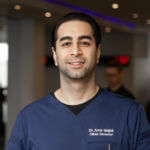Unlock Independence: How Can Physiotherapy Help Stroke Patients?
Key Takeaways
-
Physiotherapy plays a crucial role in stroke rehabilitation and recovery. It allows patients to move freely, stand tall, and take the steps that lead to a healthy and productive life.
-
Tailored treatment strategies focus physiotherapy techniques to target the specific obstacles and goals of each stroke survivor.
-
Early intervention and targeted exercises to promote movement greatly increase neurological recovery. They assist in rewiring neural pathways and rebuilding motor functions.
-
These issues including impaired motor function, fatigue, and emotional distress can all be managed through appropriate physiotherapy interventions with ease.
-
Methods including task-specific motor training, balance retraining, and gait training are critical in helping patients reclaim their strength, flexibility, and functional capabilities.
-
Regular rehabilitation for stroke patients helps regain physical strength and mobility while heightening mood, self-assurance, and drive throughout the rehabilitation process.
Physiotherapy helps stroke patients by improving mobility, strength, and coordination through tailored exercises. It supports recovery by addressing muscle weakness, balance issues, and joint stiffness, promoting independence in daily activities.
Techniques like gait training and stretching can enhance walking ability and reduce spasticity. Physiotherapists use tools such as resistance bands and parallel bars to create safe, effective rehabilitation plans.
These interventions contribute to better quality of life and long-term functional outcomes for stroke survivors.
Understanding Physiotherapy for Stroke Recovery
Physiotherapy is a critical component of stroke recovery. It addresses the physical, emotional, and functional limitations that stroke survivors must overcome to lead independent lives. It includes tailored therapeutic interventions focused on the development of movement patterns, retraining motor skills, and increasing the quality of life.
By meeting patients where they are and emphasizing recovery over time, physiotherapy helps individuals regain their independence and acclimate to their new physical realities.
What Is Physiotherapy for Stroke Patients
Curriculums—such as the one developed by the American Stroke Association—recommend using physiotherapy techniques like strength training, balance exercises, gait retraining, and more to support stroke recovery. For example, hydrotherapy produced highly significant results in improving balance and walking function within a short four-week period.
That’s why we customize each treatment plan to address the individual needs of our patients. We know the conditions like limb weakness and aphasia can differ significantly from person to person. Rehabilitation is usually a team effort with physiotherapists, occupational therapists, and other specialists working together to treat both the body and mind.
How Physiotherapy Supports Neurological Recovery
Physiotherapy takes advantage of neuroplasticity, the brain’s ability to rewire itself, to regain functions lost from a stroke. Targeted exercises like repetitive arm or leg movements restore lost motor functions.
This is why early intervention is key. Even more dramatic recoveries are seen in the first couple of weeks as swelling goes down and neural adaptation takes place.
Common Challenges Addressed by Physiotherapy
Often, stroke survivors experience both physical effects, including muscle weakness and balance problems, as well as emotional complications, including fatigue and frustration. Physiotherapy addresses these barriers with scheduled physiotherapy sessions and teaching on how to conserve energy.
It provides emotional support, reinforcing both physical strength and mental grit.
Key Techniques Used in Physiotherapy
Physiotherapy is a vital component of stroke recovery, helping to overcome the physical obstacles that develop post-stroke. The highly effective techniques used are aimed at improving mobility, increasing strength and regaining independence. Each technique is tailored to address the specific needs of each individual patient.
Here’s an overview of some of the primary evidence-based techniques employed in physiotherapy.
1. Improving Mobility Through Motor Training
Motor training addresses the improvement of coordination and use of affected muscles. Activities including repetitive limb exercise, active-assisted range of motion, and task-specific movements increase function in post-stroke patients.
For instance, a patient might practice extending her arm to grab items to help rehabilitate her upper extremities. Regular and repeated practice is the critical component here. This repetition builds and reinforces neural pathways, assisting in the rehabilitation process.
2. Enhancing Balance and Postural Control
Balance exercises, such as standing on one leg or transferring weight from one foot to the other, increase stability. These exercises decrease the likelihood of falling, giving older adults more confidence to engage in their daily activities.
Throughout the process, physiotherapists track progress and tailor exercises to help you achieve your specific goals.
3. Restoring Strength and Flexibility
Progressive resistance training, including the use of resistance bands, is safe and effective for increasing strength. Flexibility activities, such as active or passive stretching, have been shown to help with prevention of contractures and increasing range of motion.
Combined, these techniques reestablish optimal muscle function and mobility.
4. Relearning Daily Functional Activities
Task-specific training assists patients with regaining essential day-to-day activities such as eating and dressing. This method emphasizes teaching tasks by breaking them down into smaller steps, offering a real-life route to autonomy.
Kindness and understanding are key as we begin this journey.
5. Gait Training for Better Walking Ability
Gait training includes activities such as treadmill ambulation and overground gait training with use of assistive devices as indicated. This technique has shown to enhance gait pattern, decrease risk of falls, and return functional ambulation.
Research has shown that regular practice can produce dramatic improvements in recovery, sometimes in just three months.
6. Addressing Sensory and Visual Impairments
Therapeutic techniques like sensory retraining and visual scanning exercises treat impairments, including diminished sensation or vision cut. These interventions enhance the patient’s capacity to engage with their environment safely and confidently.
Emotional and Mental Benefits of Rehabilitation
The benefits of rehabilitation for stroke patients stretch much further than physical recovery. It is vital to be supportive of emotional health and mental resilience, which are key drivers of positive long-term health outcomes. Physiotherapy helps patients regain their independence, confidence, and connection to others, fostering a sense of purpose and optimism during recovery.
Reducing Emotional Stress and Anxiety
Stress and anxiety are natural emotions to feel when faced with the challenges of stroke recovery. Physiotherapists utilize techniques such as deep breathing, guided stretching, and relaxation strategies to induce calmness and alleviate tension. For instance, mindfulness practices built into a session can reduce anxiety and increase attention.
Though emotional support is a major factor as well, therapists foster open communication, making patients feel heard and understood. Research shows that about 60% of people experience a better mood and mental health with continuous, tailored treatment. This profound connection between mind and body serves to further highlight how essential it is to honor emotional well-being as improvements are made physically.
Boosting Confidence Through Progress
Physiotherapy focuses you on concrete goals, cultivating feelings of success. Patients frequently choose simple goals, like being able to walk a greater distance or move their hand, making the goal more motivating. In one patient, hand function was restored following as few as three months of individualized exercises.
This project is a reminder that constant advocacy can earn significant victories. Success stories like these offer hope and inspiration, as well as a roadmap for others who are confronted by the same challenges. Up to 75% of patients express high satisfaction with their personalized treatment plans, highlighting the program’s positive impact on confidence and self-esteem.
Encouraging Social Interaction and Support
The social aspect of rehabilitation is one of the most underrated, yet important benefits. Physiotherapy is usually done in a group setting, allowing patients to bond with one another as they work through the same experience. These exchanges help create connection and community, combating the loneliness that can accompany disability.
Including family and caregivers into the therapy process strengthens emotional support networks. This approach helps patients to not only feel supported during sessions, but throughout their day to day lives. Group therapies, and including family members, provided a therapeutic environment for stroke survivors.
This environment provides them the emotional and mental support to remain inspired and dedicated to their recovery.
Overcoming Challenges in Stroke Recovery
As anyone who has been affected by stroke knows, stroke recovery is a complex journey that requires overcoming physical, emotional, and neurological challenges. Physiotherapy is an essential component of stroke care, helping patients to regain their independence and live healthier, fuller lives.
With an emphasis on individualized tactics and gradual improvement, recovery is an achievable journey.
Dealing With Setbacks During Therapy
Setbacks are an inevitable occurrence during stroke rehabilitation. Physiotherapists are experts at helping patients move beyond these moments. Then they introduce feedback-driven modifications to therapy regimens.
This helps to keep exercises challenging and appropriate to the patient’s evolving level of ability. For example, if a patient begins to lose their balance while standing, the therapist is able to respond. They may include hydrotherapy, which research has demonstrated can greatly improve balance in as little as four weeks.
Keeping a good attitude is key. More than 70% of stroke survivors have difficulty with movement. By emphasizing minor successes like being able to walk 45 meters after 12 weeks, they can help instill hopefulness.
Our therapists work on creating clear, open lines of communication, addressing the non-linear nature of stroke recovery and the importance of patience and persistence.
Importance of Personalized Therapy Plans
Individualized therapy is at the heart of effective stroke recovery. These plans consider a patient’s specific needs, such as spasticity management through stretching or improving gait speed.
For example, patients walking at 0.8 m/s often achieve community ambulation, while those at 0.25 m/s aim for household mobility. Personalized approaches ensure motivation remains high, with therapists regularly assessing progress to refine treatments, maximizing outcomes.
Strategies to Stay Motivated in Recovery
-
Establish clear, measurable goals to monitor progress, such as increasing distance walked per week.
-
Have small victories, like learning how to put on clothes in the morning.
-
Develop achievable objectives, making progress the priority rather than the flawless outcome.
-
Rely on your support systems, whether that be your family, your peers, or your therapists to help push you forward.
Factors That Promote Independence
The goal of stroke recovery is to regain independence, a process that requires the rebuilding of both physical ability and confidence in functionality and functional autonomy. Physiotherapy serves an essential function along this path by helping patients learn individualized strategies, adaptive techniques and long-term self-management strategies.
Regaining Control Over Daily Activities
One of the primary goals is to enable stroke survivors to manage everyday tasks, such as dressing, bathing, and eating, with greater ease. Physiotherapists utilize task-specific training, decomposing activities into smaller, more manageable parts.
For example, working on grasp-and-release activities can assist patients with relearning the skills needed to pick up and hold utensils or button shirts. Repetition, repetition, repetition. This is the part where practice makes perfect—repetition builds connections within the brain.
Evidence shows that consistent practice, such as six weeks of gait training, can restore up to 80% of function after an acute stroke. Gradually reintroducing patients to their daily routines builds familiarity and confidence, paving the way for smoother transitions back to normalcy.
Reducing Dependence on Caregivers
Physiotherapy similarly focuses on decreasing dependence on caregivers by promoting independence. Strength and balance exercises, for example, help patients stand without fear of falling or walk from room to room without needing a cane or walker.
Research shows that treadmill training with physiotherapy increases gait function drastically, allowing patients to walk without assistance. Physiotherapists approach challenges in an incremental way.
This method doesn’t just build physical capacity, but it develops the mental toughness needed to live independently.
Building Long-Term Self-Sufficiency
The path to long-term independence involves long-term commitment and a lifestyle change. Early mobilization combined with stretching helps keep muscles long and avoids stiffness, which is important to overall mobility long term.
Physiotherapy programs change as patients progress. They feature things like walking at 0.8 meters per second, which is really important for allowing someone to get from one side of their community to the other.
Beyond structured therapy, ongoing support and access to resources ensure recovery continues for years, helping patients regain their strength and confidence.





